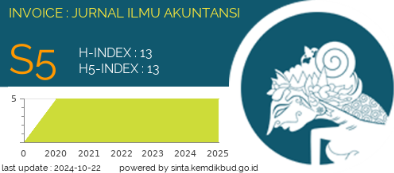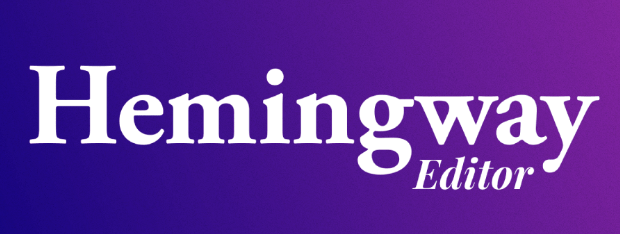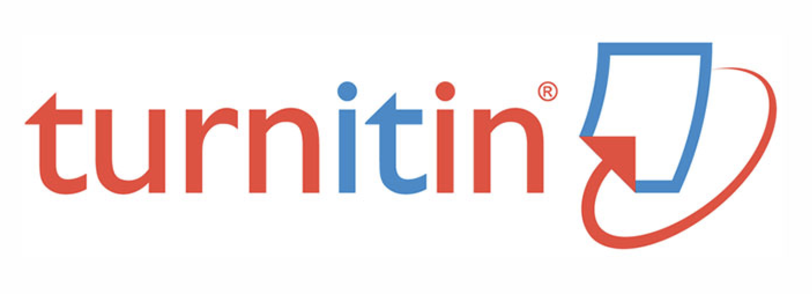Format
- Systematics of writing at least includes Title, Abstract, Background, Research Methods (Model Development), Results and Discussion (attachments in the form of tables, pictures, equations, and quotations), Conclusions, Acknowledgments (if any) , and References.
- The upper, lower, left and right sides are at least 3 cm.
- Articles are written as efficiently as possible according to needs, with articles ranging from 6-30 pages (including pictures and tables). Attach DOC and PDF formats during the application
- Articles are typed in the MS Word program on A4 paper (29.7 cm x 21 cm). With normal Times New Roman typeface, 1,15 space.
Article Writing Systematics
- A. TITLE
- The title of the journal "Invoice" Muhammadiyah University of Makassar is written in capital letters with a maximum of 15 words Times New Roman type 14 Bold.
- First Author's Name; Second Author; Next author, written without a title using the Times New Roman 9 Bold typeface (all the writers’ full names, no abbreviation).
- Address of th e institution of origin of the author, including e-mail using Times New Roman font 09.
- B. Abstract
- The abstract title uses Times New Roman 10 bold typeface. The abstract must be contented as well as Problem Statement", Approach, Result and Conclusion.
- Written on the center of the paper with a margin of 3 cm from each side with the format of one column.
- Written in Indonesian and English. Solidly stated in one paragraph one space, consisting of 100-300 words (Cambria) font 10 for Body Text.).
- Keywords are written under abstract text, Consists of five keywords (the first character is written with a capital letter, split by a coma (,) and italic for Indonesian abstract and keywords.
- C. BACKGROUD
- The preliminary title is written using a capital type, Times New Roman 11 bold.
- Use at most three title levels, chapter, part, and sub part. The first level title for chapter title uses font 11, bold, regular, and capital. Let one line empty before the first title level.
- The second title level must use font 11, bold, and every first word on a new sentence should be initially capitalized. Whether one line before the title remains empty or not is possible, but one line after the title must not be empty.
- The third title level must use font 11, italic, bold, and every first word on a new sentence should be initially capitalized. Whether one line before the title remains empty is possible, but one line after the title must not be empty. Giving another title below the title must be avoided.
- The manuscript is made in 2 columns, the distance between columns is 1 cm. Right and left margins of 3 cm each. The top margin is 3 cm and the bottom 3 cm.
- Between the title of the new chapter and the end of the previous article given a space of 1,15 space.
- D. METHOD
- The Title Method is written using a capital type, Times New Roman 11 bold.
- Subtitles are written with capital letters, Times New Roman 11 bold. Whereas the subtitles are written in Times New Roman 11 bold with capital letters at the beginning of the sentence. Then for sub-subtitles, italic / italic with Times New Roman 11 bold.
- Describe all the methods used in your research, which can be comparative or narrative for several case studies or research projects. Can also be experimental work. These methods must consist of all the step-by-step research carried out.
- E. RESULTS AND DISCUSSION
- Subtitles are written with capital letters, Times New Roman 11 bold. Whereas the subtitles are written in Times New Roman 11 bold with capital letters at the beginning of the sentence. Then for sub-subtitles, italic / italic with Times New Roman 11 bold.
- Describe all results that contain data analysis, answer research questions, test hypotheses, and interpret findings.
- F. CONCLUSIONS
The conclusion is to answer the question of the research. It is written in an essay form, not a numerical one. In a conclusion, there are no table and figure. In this part, the weakness of the research can be stated, but suggestion can be proposed to continue the same research.
- G. REFERENCES
- Bibliography written according to the rules of writing sorted alphabetically by the first name of the First Author. List all authors no more than 3 people. If more than 3 people, write the names of the first 3 authors and subsequently dkk / et al.
- Only references cited in the manuscript are included. Prioritize bibliography from journals, published in the last 5 years.
- Bibliography is written 1 (one) column, in the following order: Name, Year, Title, Edition, Publisher, City, Referenced page. The examples below can be seen in detail.
- Writing a bibliography "Reference" is arranged according to the quotation order. The serial numbers that is put inside the square brackets [1] use tabulation (hanging) 5mm. Use Times/Times New Roman 10 as shown below.
Thesis/Disertasion/Working paper
Busato L (2003) Passive cooling and energy efficient strategies for the design of a hotel on the Southern coast of Pernambuco, Brazil.Buku
Kurowski, PM (2016) Thermal Analysis with SOLIDWORKS Simulation 2016 and Flow Simulation 2016: SDC Publications. ISBN: 978-1-63057-011-8.
Article
Latif, S, Hamzah B, Ihsan (2016) Pengaliran Udara untuk Kenyamanan Termal Ruang Kelas dengan Metode Simulasi Computational Fluid Dynamics. Sinektika, Vol. 14, Issue. 2: pp. 209-216.
Website
Thomas M (2012). Comfort Cooling in Buildings. Noesis: Energy (https://www.noesisenergy.com/site/noesis-corporateblog/comfort cooling-buildings, accessed 12 January 2013).
Workshop/Seminar
Cherian R (2011) Natural ventilation for high-rise buildings in a hot humid clim. Paper presented at Network for Comfort and Energy Use in Buildings (NCEUB), London.
Attachment
- Attachments in the form of tables, figure, equation, terms and quotations.
- Table number must be put above the table, the range is 12.5 mm, and the table is aligned to both the right and the left. The table title uses Times/ Times New Roman 11, bold, and every first word on a new sentence should be initially capitalized.
- The table information is written below the table and is recommended to use smaller fonts than font 11. The table number is written in a range, and the position is close to the first referenced place. One line among the table, label, and text should be empty. The table must be automatically suitable with one column, or all the widths are more than two columns, and line or vertical limit is not necessary.
- Figure and Table must use the same size as the column width as shown in the example of Table 1 and Figure 1, or all the widths are more than two columns. Giving texts next to Table or Figure is not allowed. The texts should be written at the end.
- The figure number and label must be positioned one line below the figure with 12.5 mm and be aligned to the left and the right. The figure number should be in a range based on the range of figure references.
- The figure position is close to the figure information. Please do not compress the figure (300 dpi resolution, or more is preferred). The figure number should be clear, and a text should be attached inside the figure correctly. Do not copy and stick other texts. Make sure that the figure is beautiful and readable after printing. Do not use outer limit. The figure should be fully positioned in one column or in the whole paper width / two columns.
- You can use colored figure and photo in your manuscript. The colored object will exist in the form of online journal. However, please make sure that the text and your colored figure are readable when printed in monochrome (black and white).
- The equation and symbol must be typed in the equation editor. Write in an aligned left margin and give sequential numbers inside the brackets. The numbers are positioned at the end of the right margin from the column.
- The equation number is attached inside the brackets and is positioned on an aligned right margin from the column. The symbol and notation should be defined when they appear at the first time. Let one line empty before and after the equation. The equation should be positioned in one column or in the whole paper width.
10. The quotation is written in order inside the square brackets [1]. The sentence content in a paragraph follows the brackets [2]. Various references [3,4] and various quotations are numbered in brackets at the same time [5-9]. When quoting a book, please include the relevant pages. In a sentence, it refers only to the reference number, as in [3]. Do not use "Ref. [3] "or" reference [3] "except at the beginning of a sentence:" Latif [3] shows .... "
Review Process
The review process is done via correspondence via email. Invoice journals do not service meetings with journal editors, reviewers or managers.
Articles that are submitted for publication in a journal, will first be examined by the editor. The process carried out by the editor lasts a maximum of 7 days per inspection. The editor will provide the opportunity for the writer to correct the writing 2 times, if it still does not meet the criteria set by the editor, then the article can be rejected for publication. The editor will assess whether the writing has fulfill:
- Systematics of writing
- Conformity of the writing theme with the scope of the scientific field of the journal
- Fulfillment of scientific rules in writing
- Writing errors and completeness of the references
Articles that have been checked by the editor will be reviewed by experts in their fields. Reviewers will rate:
- Hypothesis quality
- Accuracy of research methods to prove hypotheses
- Framework for thinking and scientific quality and truth in the process of drawing conclusions
Each examination by the reviewer will last for 9 days. Only papers that have been reviewed will be published in a journal. Improvements by the author will be assessed again by the reviewer, if the writing requires major (major) improvements. The author must return the results of repair for 7 days. The time for repairs by the author for major repairs is 7 days, while for minor repairs are 3 days.
The entire process in the editor and reviewer will be done anonymously (blind process). Journal managers will not provide names and institutional information to reviewers or authors. Reviewers can come from Unismuh or other universities.
To speed up the assessment process by editors and reviewers, the authors are expected to enter their articles without typing errors and have met the systematic recommended by this journal.
Article Processing Fee
Each article submitted to the editorial office of Invoice: Jurnal Ilmu Akuntansi, with registered number p-ISSN 2714-6359 dan e-ISSN 2714-6340, is free of charge including article processing. The publication cost is borne by the journal publisher.
Plagiarism Policy
If plagiarism is found outside the rules above, the editor of the Invoice Journal has the right to provide action in accordance with the policies of the team editor. Every writer submitting articles to Invoice must produce a letter requesting that the manuscript be free of plagiarism and also not being published and published in other journals. Editors will still screen plagiarism with Turnitin and are responsible for accepting or rejecting writing.
Availability Data Policy
Consistent with the objectives of Invoice, the article writer is expected to be able to provide the requested data to the requested person and provide information on how to obtain the data. If the article uses a survey or experiment, all instruments (questionnaires, cases, interview plans, etc.) must be attached.
Article Submission
Articles are sent in soft copy (without the author's identity) and completed with a brief CV of the author and research instruments (questionnaire, interview results, etc.). Articles are sent through the Invoice website: http://journal.unismuh.ac.id/index.php/Invoice by selecting the Send Paper menu and will use the application using the Open Journal System (OJS). Instructions for using OJS for writers can be seen in the OJS Guidelines menu.










